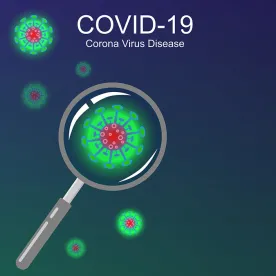On Friday, May 22, 2020, the Small Business Administration (SBA) released two new Interim Final Rules (collectively, the Rules) governing Paycheck Protection Program (PPP) loans: (1) the Loan Forgiveness Requirements (Forgiveness Rule) and (2) the SBA Loan Review Procedures and Related Borrower and Lender Responsibilities (Lender Responsibility Rule). These Rules provide lenders of PPP loans (Lenders) some of the first clear answers on their responsibilities with respect to processing PPP Loan Forgiveness Applications, and it is fair to say that those responsibilities likely exceeded what many Lenders expected, much less desired. This memorandum summarizes the requirements and procedures the new Rules place on Lenders for reviewing PPP loans and Loan Forgiveness Applications, and suggests some unanswered questions raised by them.
Lender Determination of Forgiveness
Most importantly, the Rules make it clear that the initial determination of whether a PPP loan should be forgiven, and if so, in what amount, is to be made by the Lender, subject to review by the SBA. Section 2 of the Forgiveness Rule states that “[a]s a general matter, the lender will review the [borrower’s Loan Forgiveness] application and make a decision regarding loan forgiveness.” Section 2.b. of the Lender Responsibility Rule states that a Lender “must issue a decision to SBA on a loan forgiveness application not later than 60 days after receipt of a complete loan forgiveness application from the borrower.” Therefore, the initial forgiveness decision will be made by the Lender, after which the “SBA will, subject to any SBA review of the loan or loan application, remit the appropriate forgiveness amount to the lender, plus any interest accrued through the date of payment, not later than 90 days after the lender issues its decision to SBA.” Placing the primary responsibility on Lenders for determining a borrower’s eligibility for loan forgiveness, as opposed to acting as a conduit of information between the SBA and borrowers, diverges from the expectations of many observers, Lenders included.
Lender Review Requirements
Section 2.a. of the Lender Responsibility Rule requires a Lender, when making a decision on a PPP Loan Forgiveness Application, to do the following:
1. Confirm receipt of the borrower certifications contained in the Loan Forgiveness Application (SBA Form 3508).
2. Confirm receipt of the documentation borrowers must submit to aid in verifying payroll and nonpayroll costs, as specified in the instructions to the Loan Forgiveness Application:
a. Payroll Costs:
i. Bank Account Statements or third-party payroll service provider reports documenting the amount of cash compensation paid to employees;
ii. Tax forms (or equivalent third-party payroll service provider reports) for the periods that overlap with the Covered Period or the Alternative Payroll Covered Period (as defined in the instructions to Form 3508):
1. Payroll tax filings reported, or that will be reported, to the IRS (typically, Form 941); and
2. State quarterly business and individual employee wage reporting and unemployment insurance tax filings reported, or that will be reported, to the relevant state; and
iii. Payment receipts, canceled checks, or account statements documenting the amount of any employer contributions to employee health insurance and retirement plans that the Borrower included in the forgiveness amount (PPP Schedule A, Lines 6 and 7 of Form 3508).
b. Nonpayroll Costs:
i. Business mortgage interest payments: Copy of lender amortization schedule and receipts or cancelled checks verifying eligible payments from the Covered Period; or lender account statements from February 2020 and the months of the Covered Period through one month after the end of the Covered Period verifying interest amounts and eligible payments;
ii. Business rent or lease payments: Copy of current lease agreement and receipts or cancelled checks verifying eligible payments from the Covered Period, or lessor account statements from February 2020 and from the Covered Period through one month after the end of the Covered Period verifying eligible payments; and
iii. Business utility payments: Copy of invoices from February 2020 and those paid during the Covered Period and receipts, cancelled checks, or account statements verifying those eligible payments.
3. Confirm the borrower’s calculations on the borrower’s Loan Forgiveness Application, including the dollar amount of the following by reviewing the documentation submitted with the Loan Forgiveness Application as described in number 2 above:
a. Cash Compensation, Non-Cash Compensation, and Compensation to Owners claimed on Lines 1, 4, 6, 7, 8, and 9 on PPP Schedule A; and
b. Business Mortgage Interest Payments, Business Rent or Lease Payments, and Business Utility Payments claimed on Lines 2, 3, and 4 on the PPP Loan Forgiveness Calculation Form.
4. Confirm that the borrower made the calculation on Line 10 of the Loan Forgiveness Calculation Form correctly, by dividing the borrower’s Eligible Payroll Costs claimed on Line 1 by 0.75.
The Lender Responsibility Rule reiterates that providing an accurate calculation of the loan forgiveness amount is the responsibility of the borrower, who attests to the accuracy of its reported information and calculations on the Loan Forgiveness Application. The Lender Responsibility Rule also states, however, that Lenders are expected to perform a good-faith review, in a reasonable time, of the borrower’s calculations and supporting documents. The Lender Responsibility Rule clarified through example that minimal review of calculations based on a payroll report by a recognized third-party payroll processor would be a reasonable review for a Lender, but that a Lender would be expected to conduct a more extensive review of calculations and data if payroll costs are not documented with such recognized sources. The Rules also state that borrowers shall not receive forgiveness without submitting all required documentation to the Lender.
Lender Options
According to the Lender Responsibility Rule, the Lender’s decision on forgiveness may take the form of (i) an approval (in whole or in part); (ii) denial; or (iii) (if directed by SBA) a denial without prejudice due to a pending SBA review of the loan for which forgiveness is sought, in which case the borrower may subsequently request the Lender to reconsider its application for loan forgiveness, unless SBA has determined that the borrower is ineligible for a PPP loan.
The Lender Responsibility Rule also states that when the Lender issues its decision to SBA approving an application (in whole or in part), the decision must include the following: (a) the PPP Loan Forgiveness Calculation Form, (b) PPP Schedule A, and (c) the optional PPP Borrower Demographic Information Form (if submitted to the Lender). The Lender must confirm that the submitted information accurately reflects the Lender’s records for the loan, and that the Lender has made its decision in accordance with the requirements listed in numbers 1–4 above. Finally, the Lender must request payment from SBA at the time the Lender issues its decision to the SBA, and SBA will, subject to any review of the loan or loan application, remit the appropriate forgiveness amount not later than 90 days following that submission, as mentioned above.
Lender Denial of Forgiveness
If the Lender issues its decision to SBA determining that the borrower is not entitled to forgiveness in any amount, the Lender must provide SBA with the reason for its denial, along with the following from the Loan Forgiveness Application (Form 3508): (a) the PPP Loan Forgiveness Calculation Form, (b) PPP Schedule A, and (c) the optional PPP Borrower Demographic Information Form (if submitted to the Lender). As with the approved application, the Lender must also confirm that the information provided by the Lender to SBA accurately reflects the Lender’s records for the loan, and that the Lender has made its decision in accordance with the requirements listed in numbers 1–4 above. The Lender must also notify the borrower in writing that the Lender has issued a decision to SBA denying the Loan Forgiveness Application. Within 30 days’ notice of denial from the Lender, a borrower may request that the SBA review the Lender’s decision.
SBA Review
The Rules state that the SBA will use the 90-day period allowed for payment of the forgiveness amount to ensure that all applicable legal requirements for the PPP loan and its forgiveness have been satisfied. They also say that the SBA may begin a review of any PPP loan of any size at anytime in SBA’s discretion without clarifying how that statement reconciles with Frequently Asked Question (FAQ) Number 46, issued on May 13, 2020. FAQ 46 states that the SBA, in consultation with the Department of Treasury, has determined that any borrower that received PPP loans with an original principal amount of less than $2 million will be deemed to have made the required certification concerning the necessity of the loan request in good faith; however, the implication of the Lender Responsibility Rule is that the safe harbor created by FAQ 46 may be narrower than originally thought. It is possible that loans with a principal amount less than $2 million may still be audited on other grounds.
If the SBA undertakes such a review, the SBA will notify the Lender in writing, after which the Lender must notify the borrower in writing within five days of receipt. The Lender must also, within that same five (5)-day period, transmit to SBA electronic copies of the following:
-
The Borrower Application (Form 2483) and all supporting documentation provided by the borrower;
-
The Loan Forgiveness Application (Form 3508) and all supporting documentation provided by the borrower (NOTE: If the Lender receives such a forgiveness application after it receives notice that SBA has commenced a loan review, the Lender shall transmit electronic copies of it and all supporting documentation to SBA within five (5) business days of receipt; the Lender is also not allowed to approve such application until notice from the SBA that the review of the loan is complete.);
-
The Lender must also request that the borrower provide the Lender a copy of the Schedule A Worksheet to the Loan Forgiveness Application, after which the Lender will have five (5) business days to submit that worksheet to SBA.
-
-
A signed and certified transcript of account (the Rules provide no further guidance on what this should consist of);
-
A copy of the executed note evidencing the PPP loan; and
-
Any other documents related to the loan requested by SBA.
The Lender Responsibility Rule states that the SBA is authorized to review the following:
-
Borrower Eligibility, i.e., whether a borrower is eligible for the PPP loan based on the provisions of the Coronavirus Aid, Relief, and Economic Security (CARES) Act, the rules and guidance available at the time of the borrower’s PPP loan application, and the terms of the borrower’s loan application. These include, but are not limited to:
-
SBA regulations under 13 CFR § 120.110 — While the Lender Responsibility Rule states that PPP loans will be judged based upon the rules and guidance available at the time of a borrower’s PPP loan application, it does not clarify how an application that may not have been eligible under 13 CFR 120.110 at the time it was submitted would be treated if a later rule was issued making such borrower eligible (outside directors of Lenders, owners of less than 30% of equity in Lenders, gambling enterprises, electric cooperatives, government-owned hospitals, etc.).
-
13 CFR § 121.301(f), i.e., the affiliation rules.
-
The information, certifications, and representations on the Borrower Application (Form 2483) and Loan Forgiveness Application (Form 3508).
-
-
Loan Amounts and Use of Proceeds, i.e., whether or not a borrower calculated the loan amount correctly and used loan proceeds for the allowable uses specified in the CARES Act; and
-
Loan Forgiveness Amount, i.e., whether a borrower is entitled to loan forgiveness in the amount claimed on the Loan Forgiveness Application (Form 3508).
Document Retention
For the purpose of possible review by the SBA, the borrower must retain PPP documentation in its files for six (6) years after the date the loan is forgiven or repaid in full, and Lenders must comply with applicable SBA requirements for records retention, which means:
-
For federally regulated Lenders, requirements of the Lenders federal financial institution regulators; and
-
For SBA-supervised Lenders (i.e., non-depository Lenders), compliance with the requirements of 13 CFR § 120.461.
SBA Request for Additional Documentation From Borrower
The Lender Responsibility Rule adds that if loan documentation submitted to SBA by a Lender, or any other information, indicates that the borrower may be ineligible for a PPP loan or may be ineligible to receive the loan amount or loan forgiveness amount claimed by the borrower, the SBA will require the Lender to contact the borrower in writing to request additional information. SBA may also request information directly from the borrower, and the Lender will provide the SBA any additional information provided to it by the borrower. Failure to respond to SBA’s inquiry for information may result in a determination that the borrower was ineligible for a PPP loan or ineligible to receive the loan amount or loan forgiveness amount claimed by the borrower. Again, as stated above, the Lender will have five (5) business days to submit information to the SBA when the SBA notifies it in writing of a review, but it is unclear from the Rules how that deadline would apply to further information that the SBA requires the Lender to request from the borrower.
Ineligibility
Probably the most important part of the Rules to Lenders is in Section 1.e of the Lender Responsibility Rule, which addresses whether the loan can be forgiven following a determination from the SBA that a borrower is ineligible for a PPP loan. Predictably, the answer is no, and the Lender Responsibility Rule states that the SBA will direct the Lender to deny the loan forgiveness application of any borrower that is ineligible for the PPP loan, in which case the SBA may also seek repayment of the outstanding PPP loan balance or pursue other available remedies. Presumably it would be up to the Lender at that point to collect the loan proceeds that it has advanced to the borrower without forgiveness from the SBA. The Lender Responsibility Rule goes on to say that such a denial would be required if a borrower is not an “eligible recipient,” and that the Lender is not eligible for a processing fee if the SBA determines that a borrower is ineligible for a PPP loan following a review. Even more concerning is that the Lender Responsibility Rule states that the SBA will seek repayment of the Lender’s processing fee for any SBA-reviewed PPP loan if the SBA determines, within one year after the loan was disbursed, that a borrower was ineligible for a PPP loan based on the provisions of the CARES Act, applicable rules and guidance available at the time of the borrower’s loan application, or the terms of the loan application.
The Lender Responsibility Rule does provide for the right of a borrower to appeal the SBA’s determination that it is ineligible and states that an additional interim final rule will be issued setting forth the procedures for such appeals.
Guaranty
The Lender Responsibility Rule says that the SBA’s determination of borrower eligibility will have no effect on the SBA’s guaranty of the loan if the Lender has complied with the document collection and retention requirements described in the Lender Application (Form 2484) as well as the following obligations under Section III.3.b of the first PPP interim final rule published at 85 FR 20811 (First Interim Final Rule):
i. Confirmed receipt of borrower certifications contained in Form 2483;
ii. Confirmed receipt of information demonstrating that a borrower had employees for whom it paid salaries and payroll taxes on or around February 15, 2020;
iii. Confirmed the dollar amount of average monthly payroll costs for the preceding calendar year by reviewing the payroll documentation submitted with the borrower’s application; and
iv. Followed applicable Bank Secrecy Act requirements.
However, if a Lender fails to satisfy those requirements set forth on Form 2484 and in the First Interim Final Rule, the SBA will not only seek repayment of the Lender’s processing fee, it may also determine that the loan is not eligible for a guaranty.
Conclusion
While the new Rules provide a great deal of new information and some clarification on the process for reviewing PPP loan forgiveness applications as well as the procedures for and requirements for Lenders related to a review of a PPP loan by the SBA, they leave some unanswered questions. For example, the Rules do not definitively state whether or not a Lender should await payment from the SBA of a forgiven amount before communicating a decision on the allowed forgiveness to the borrower. Assuming that is the case, it appears that the borrower may not be notified that the loan will actually be forgiven until 150 days after submission of a complete Loan Forgiveness Application since the Lender will have 60 days after receiving the submission to notify the SBA of its decision and the SBA will have another 90 days to pay the forgiven amount to the Lender after it receives the Lender’s decision on forgiveness. It is clear, though, that if a Lender decides to deny forgiveness, it must notify the borrower in writing of that denial, after which the borrower may request an SBA review of the Lender’s decision within 30 days of receiving the notice. Another very important topic is the advance purchase of PPP loans by the SBA, which the First Interim Final Rule said could be requested by Lenders at the end of week seven of the Covered Period. However, according to the Lender Responsibility Rule, that process will be addressed in a separate, subsequent rule. While acknowledging that the first PPP loans were disbursed after April 3, or approximately eight weeks ago, the new Rules do not state when Lenders might expect to request advance purchases that arguably should already be allowed.







 />i
/>i

